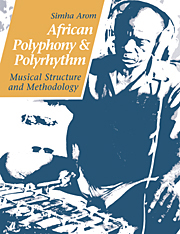Book contents
- Frontmatter
- Contents
- List of illustrations
- Foreword by György Ligeti
- Preface
- Acknowledgements
- BOOK I THE MUSIC OF THE CENTRAL AFRICAN REPUBLIC
- Map
- 1 General introduction
- 2 The general features of traditional music
- 3 Typology
- BOOK II AFRICAN POLYPHONIC MUSIC
- BOOK III TECHNICAL TOOLS: METHODS OF RECORDING POLYPHONIC MUSIC FOR TRANSCRIPTION
- BOOK IV THEORETICAL TOOLS
- BOOK V THE ORGANISATION OF TIME IN AFRICAN MUSIC
- BOOK VI STRUCTURAL PRINCIPLES AND THEIR APPLICATION
- Conclusion
- Bibliography
3 - Typology
Published online by Cambridge University Press: 27 January 2010
- Frontmatter
- Contents
- List of illustrations
- Foreword by György Ligeti
- Preface
- Acknowledgements
- BOOK I THE MUSIC OF THE CENTRAL AFRICAN REPUBLIC
- Map
- 1 General introduction
- 2 The general features of traditional music
- 3 Typology
- BOOK II AFRICAN POLYPHONIC MUSIC
- BOOK III TECHNICAL TOOLS: METHODS OF RECORDING POLYPHONIC MUSIC FOR TRANSCRIPTION
- BOOK IV THEORETICAL TOOLS
- BOOK V THE ORGANISATION OF TIME IN AFRICAN MUSIC
- BOOK VI STRUCTURAL PRINCIPLES AND THEIR APPLICATION
- Conclusion
- Bibliography
Summary
INTRODUCTION
Although each human group has its own musical idiom, the musics of the peoples living in the Central African Republic have many common characteristics. The general principles upon which these different musics are based show a certain degree of uniformity. I shall summarise these general principles as a way of introducing an analysis of the polyphonic and polyrhythmic musics which are the subject of this study.
But before briefly surveying the general features of traditional Central African music, let me remind the reader that, as in most African societies, this music is popular, oral, anonymous, undatable, collective, and for internal use.
– Popular music as opposed to ‘art’ music because it does not require knowledge of any formal theory on the part of those who inherit it and perform it. The African musician does not verbalise the abstract principles upon which his music is based.
– Oral music, because it has no notation and is transmitted from generation to generation by word of mouth and memorisation only.
– Anonymous and undatable music: its possessors cannot say either who composed the pieces they have inherited, nor when it was first performed.Collective music, because the whole community, inasmuch as it is a cultural entity, is responsible for its preservation and subsequent transmission.
– Music for internal use, because, produced in the society in question, by and for its own members, it constitutes a means of expression and communication – even of communion – that is peculiar to the society, just as much as its natural language is.
VOCAL AND INSTRUMENTAL MUSIC
The Central African peoples, like so many others in Black Africa, do not generally distinguish vocal from instrumental music.
- Type
- Chapter
- Information
- African Polyphony and PolyrhythmMusical Structure and Methodology, pp. 16 - 30Publisher: Cambridge University PressPrint publication year: 1991



